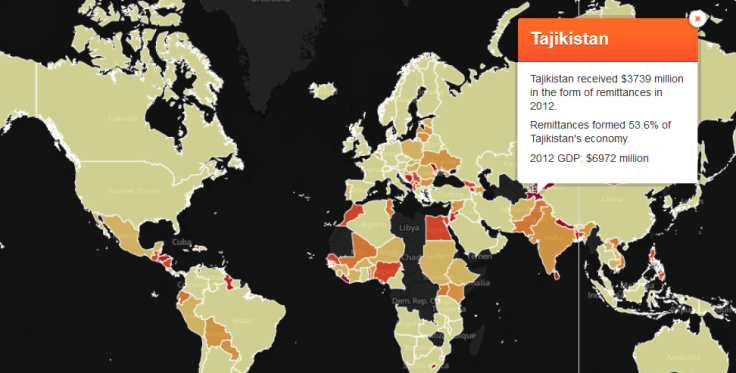Remittance Economies: How Migrant Workers Are Shaping The Economies Of Their Home Countries [MAPS]

More than 230 million people were living outside their country of birth in 2013, and many of them sent money home. Migrant workers worldwide sent home $526 billion in 2012, according to World Bank estimates.
Developing countries received $401 billion of those $526 billion of migrant remittances in 2012, according to the World Bank. By 2016, that number is expected to cross the $700 billion mark.
For small and poor countries like Tajikistan and the Kyrgyz Republic, these migrant remittances are one of the major driving forces behind their economies.
Remittances formed more than half Tajikistan's GDP in 2012, and about a third in the Kyrgyz Republic.
For some economies, remittances play another very important role -- access to foreign exchange. In Pakistan, Bangladesh, Nepal and Sri Lanka, money received in remittances are larger than national foreign exchange reserves, according to the World Bank.
Small economies aren’t the only ones that are swayed by income from remittances. India and China, two of the world largest economies, received upwards of $60 billion in remittances each in 2012.
For India, the country to receive the most remittances in 2012 -- a whopping $69 billion -- remittances account for more income than IT exports.
Here’s a map of countries color-coded by the amount of money they received in remittances in 2012:
Here’s the same map, except this one color-coded by the percentage of GDP that remittances form. Here, it is easy to see which countries are the most dependent on remittance income.
Compare the two maps using the slider:
Note on the data: The World Bank uses a statistical model to estimate the amount of money coming and flowing into each country. The maps above feature data from the World Bank’s statistical model, with the exception of data for Canada, Kuwait, Qatar and Timor-Leste. The data for these four countries come from the original data collected by the World Bank, and not the statistical model.
© Copyright IBTimes 2024. All rights reserved.












